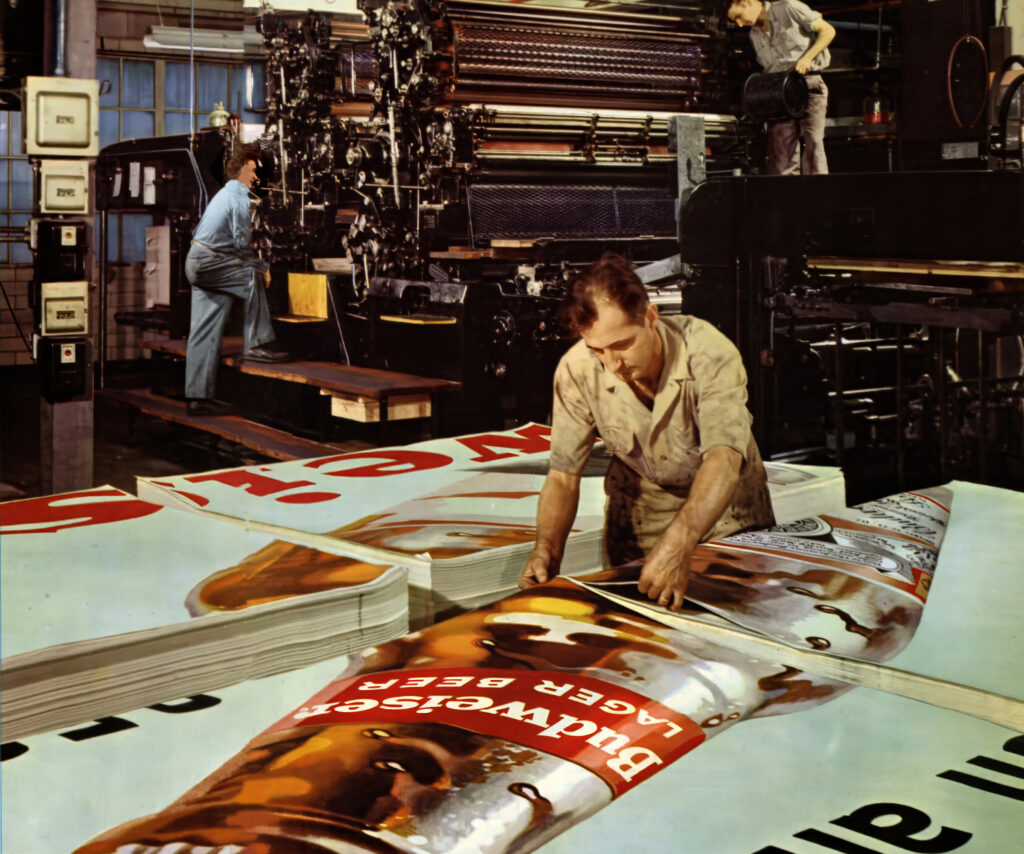
Features
Chronicle
Opinion
When it was time to go big
How VLF offset presses found redemption on billboards
May 21, 2024 By Nick Howard
 A Harris 272 press printing a Budweiser Poster at Western Printing & Litho Co. This photo was taken in 1952. Photo © Nick Howard
A Harris 272 press printing a Budweiser Poster at Western Printing & Litho Co. This photo was taken in 1952. Photo © Nick Howard In 1982, a French printer flew from Paris carrying a large tube filled with film. His firm specialized in large-format billboards, and my company was about to sell him a Harris LTZ four-colour press with a sheet size of 54.5 x 77 in. He came to North America because he couldn’t find a press that was over 72 in. in France. Only American-based Harris and Miehle were producing VLF (very-large-format) presses. England’s Crabtree Vickers manufactured the Sovereign S/72 (47.5 x 72 in.), but it was unpopular. Italy’s Nebiolo and Germany’s MAN, Roland and Planeta stopped at 63/64-in. Therefore, American presses were in abundance and led the market.
Large-format sheetfed offset presses first came into vogue during the Roaring Twenties when plate-making methods started to improve. The only edge a printer had at that time was the ability to print more pages in less time. Web presses were still mostly letterpress, leaving sheetfed and offset’s superior print quality omnipotent. Books and magazines folded into 64-page signatures became the norm. Sheet sizes 45, 52, 60, and 72 in. spread throughout America. Large platemakers, folders and guillotines were essential and spread just as. These presses were also used to print maps, gang labels, and folding cartons.
As the decades whizzed by and offset web presses matured, the late 1950s became the tipping point for VLF sheet sizes, and sales of new monsters began to stall. With the launch of much improved, smaller offset machines, VLF presses were only being used to print folding cartons (up to 64 in.) and billboards.
During the early 20th century, most large signs were hand-painted. The 24-sheet billboard, with a nominal size of 104 x 234 in., became a staple along roadsides, towns, and cities, hawking everything from booze, tobacco, and Coca-Cola. Run lengths were often small but offset was the only technology available until the early 1990s. Soon, inkjet appeared on the scene and played havoc with VLF’s status quo.
Discarded by conventional printers, antiquated Harris and Miehle 54 x 77-in. behemoths were being repurposed as poster presses in the U.S., Canada, Switzerland, France, Britain, and Japan. But it was still a surprise when, in the late 1990s, a group of engineers from Koenig & Bauer (K&B) jetted to North America to visit printers who still used this old technology.
Inkjet shakes up the field
K&B ended up modernizing a format long considered passé. The Rapida 205, with a 59.45 x 80.70-in. sheet size, was launched in Drupa 2004, followed by a smaller Rapida 185 (51.25 x 72.75-in.). These VLF sizes, nine and eight, would soon be joined by Manroland’s 900 XXL in a sheet size of 51 x 73 in. Manufacturing billboards was now more accessible and faster than ever, but as quickly as these presses appeared, so did massive wide inkjet platforms.
Inkjet could now print an entire billboard on one substrate as compared to 12 or 24 sheets that needed to be pieced and glued onsite. With inkjet platforms requiring one operator and selling for less than 15 per cent of the cost of a multi-operator VLF, it’s easy to understand their popularity. We haven’t yet added the platemaking and cutting equipment needed for VLF though.
Today, outdoor signage is changing again with new digital billboards that can be installed or altered with the click of a mouse. Several ads can appear one after another, raising rental income tremendously. Digital signage is here to stay and will only get cheaper. Meanwhile, inkjet commands the lion’s share of billboard advertising. VLF offset presses retained a niche for over 100 years until a new technology displaced it. An impressive feat indeed.
Nick Howard, a partner in Howard Graphic Equipment and Howard Iron Works, is a printing historian, consultant, and certified appraiser of capital equipment. He can be reached at nick@howardgraphic.com.
This column originally appeared in the March/April 2024 issue of PrintAction.
Print this page
- Mondi and Meurer wake up coffee wrapping with new paper solution
- Simpson Print appoints Alec Couckuyt as COO